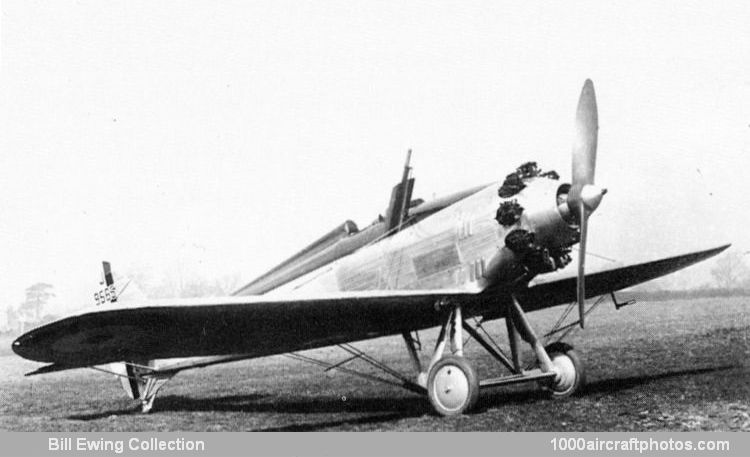There were only three interested companies: Bristol, Vickers, and Westland. Bristol's Type 112 monoplane to the F.29/27 specification would have had a Mercury III power plant, but was purely a project without an example being built. Vickers' Type 161 was a quite unique design of biplane configuration, the power plant installed in the rear of a central nacelle, and driving a pusher propeller that rotated within an open frame structure. An odd-looking feature was the spinner, a tapered tubular fairing, mounted astern of the propeller and within the frame structure.
Usually known as the C.O.W. Gun Fighter, the Westland F.29/27 was derived directly from the F.20/27 Interceptor which had been the subject of so much development, being basically a larger version of that aircraft. The overall length was increased by just over 4 ft (1.22 m), this being sufficient to make the new fighter look far more attractive and better proportioned. The fact that the F.20/27 and F.29/27 fighters were being worked on almost simultaneously is reflected in the tail unit of the latter which, as first flown, had the low aspect-ratio fin and rudder that had been seen initially on the Interceptor.
The braced low-wing had a basic all-metal structure, covered with fabric covered, and was fitted with Frise type ailerons. The rectangular-section fuselage structure was constructed of duralumin tube, faired to an oval section. The forward fuselage was covered by detachable metal panels, the aft fuselage was fabric covered. It had a conventional braced tail unit of metal structure, also fabric covered, and tail plane incidence was ground adjustable. It had a non-retractable tail-skid landing gear, and the main wheels had standard brakes.
The power plant was a 485 hp Bristol Mercury IIIA nine-cylinder air-cooled radial engine, fed by fuel contained in main and gravity fuselage tanks with a combined capacity of 76.86 gal (291 l).
Following the maiden flight, the F.29/27 had to follow the same pattern of development as its predecessor. In due course it was flown with the increased-height fin and rudder and, although it retained the Mercury IIIA engine, the four-blade propeller was replaced by one with two blades. In due course the C.O.W. gun and its prismatic gun sight was installed.
The gun, which had an overall length of 8 ft (2.44 m), was mounted in the starboard side of the cockpit so that it was easily accessible to the pilot. It was set at an angle of 55°, so that it would fire upward and forward, the prismatic sight providing an aiming point along this line of fire. The intention was to attack formations of bombers from below and behind, then a notorious blind spot, and a method of attack that was tried by the Luftwaffe during WW II, but using different weapons.
Following official trials with the Vickers and Westland prototypes, the Air Ministry lost interest in the project and the C.O.W. Gun failed to emerge as an aircraft weapon. Testing had shown that its rate of fire was inadequate, and because of the heavy weight of the shells that it fired, very few could be carried."
